In Part 3 we cover western Hungary, with its rolling hills and several lakes.
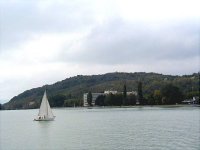 Lake Balaton is the largest lake in central Europe with an area of 592km˛ and a length of 77km (48 miles). Its shores are lined with resorts. The lake is quite shallow and is narrowest at the peninsular of Tihany with its Baroque abbey. Its southern shore is sandy and shallow, with many beaches ideal for families. The northern shore is steeper and backed by hills with hiking paths and biking trails.
Lake Balaton is the largest lake in central Europe with an area of 592km˛ and a length of 77km (48 miles). Its shores are lined with resorts. The lake is quite shallow and is narrowest at the peninsular of Tihany with its Baroque abbey. Its southern shore is sandy and shallow, with many beaches ideal for families. The northern shore is steeper and backed by hills with hiking paths and biking trails.
The most picturesque area is the Tihany peninsula on the northern side. A Baroque Bendictine Abbey is its major attraction, in addition to the many large homes surrounded by gardens.
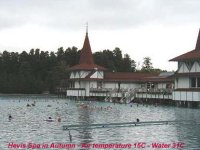 Siófok is the main resort. It lies at the end of the M7 Motorway from Budapest and has frequent train service. It is also a terminal for the lake steamers that criss-cross the lake in summertime. Close by is Balatonföldvár with beautiful flower gardens.
Siófok is the main resort. It lies at the end of the M7 Motorway from Budapest and has frequent train service. It is also a terminal for the lake steamers that criss-cross the lake in summertime. Close by is Balatonföldvár with beautiful flower gardens.
At the south-west end of the lake, Keszthely is home to the Festetics family palace. The central wing of the 360 room Baroque palace houses an interesting museum. It is surrounded by an extensive, well kept park in the English style.
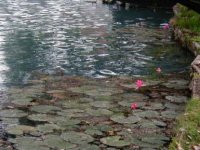 Only 6 km. from Keszthely, at
Héviz, you may bathe in Europe's largest natural hot-water lake. The water is continually replenished by a spring, so that even in winter the water temperature stays close to 20C (72F). The water-lilies thrive in this environment.
Only 6 km. from Keszthely, at
Héviz, you may bathe in Europe's largest natural hot-water lake. The water is continually replenished by a spring, so that even in winter the water temperature stays close to 20C (72F). The water-lilies thrive in this environment.
Going west from Budapest it is worthwhile to visit Esztergom.
to see the ruins of Hungary's largest Basilica, which houses a treasury of 1,000 year old historic relics. This was the birthplace of St. Stephan and the first capital of the new country. You may also visit the 12th. Cent. palace. From the top of the cupola of the Basilica you can enjoy a wonderful view of the Danube Bend and the distant mountains of Slovakia. In summer you can make a day trip from Budapest on a river boat.
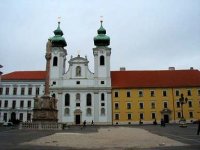 Györ is about halfway between Budapest and Vienna and is a stop for all the express trains between the two capitals. Although Györ is a modern industrial city, its ancient core is well preserved around the old Market Square (now called Szechenyi ter). The square and the neighboring streets are lined with beautiful medieval and Baroque houses, including the Esterhazy Palace. The cathedral, on top of the hill, is a mixture of styles having been continuously enlarged since the 11th.Cent. A festival of concerts, drama and ballet is held in June.
Györ is about halfway between Budapest and Vienna and is a stop for all the express trains between the two capitals. Although Györ is a modern industrial city, its ancient core is well preserved around the old Market Square (now called Szechenyi ter). The square and the neighboring streets are lined with beautiful medieval and Baroque houses, including the Esterhazy Palace. The cathedral, on top of the hill, is a mixture of styles having been continuously enlarged since the 11th.Cent. A festival of concerts, drama and ballet is held in June.
Only 18km. from Gyor lies the 1,000 year old Benedictine Abbey of
Pannonhalma.. Remains of the original walls and crypt built in 997 lie beneath the present structure of the Basilica, located on top of the hill with a commanding view. A Mass with Gregorian chants takes place at 10 o'clock, every Sunday.
.
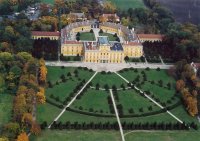 Fertöd is a small town near the Austrian border worth visiting to see the magnificent Rococo palace built by Prince Miklós Eszterházy in the 18th century. Here Haydn composed and conducted many of his best works. Today, once more, concerts are performed in the restored palace chamber.
Fertöd is a small town near the Austrian border worth visiting to see the magnificent Rococo palace built by Prince Miklós Eszterházy in the 18th century. Here Haydn composed and conducted many of his best works. Today, once more, concerts are performed in the restored palace chamber.
Continue in the westward direction. Surrounded on three sides by Austria lies
Sopron, an old town with cobblestone streets and many museums in its Gothic houses. It dates back to Roman times, in fact the clock tower, stands on the foundations of a Roman gate. To the north, the shallow, reed lined Lake Fertö (called Neusiedler See by the Austrians) provides summer recreation and bird watching. Across this lake, in 1956, refugees fled to asylum from the aborted Budapest uprising against the Soviets.
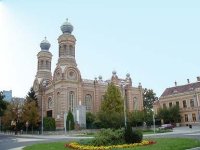 Szombathely 40km. further south, is another ancient Roman colony, but only fragments of the Roman ruins remain. A complete village museum has been built by bringing original farm homes from all over the region. The Synagogue is a remarkable structure combining many architectural elements from gothic Europe and the East.
Szombathely 40km. further south, is another ancient Roman colony, but only fragments of the Roman ruins remain. A complete village museum has been built by bringing original farm homes from all over the region. The Synagogue is a remarkable structure combining many architectural elements from gothic Europe and the East.
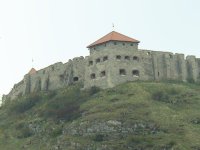 Driving east, back towards Lake Balaton, we approach a range of ancient volcanic cones. In the early Middle Ages they were utilized for the building of castles that defended the plains against the ingression of invaders. They held up the advance of the Turks for over a generation, A well preserved example of these forts is the one at Sumeg.
Driving east, back towards Lake Balaton, we approach a range of ancient volcanic cones. In the early Middle Ages they were utilized for the building of castles that defended the plains against the ingression of invaders. They held up the advance of the Turks for over a generation, A well preserved example of these forts is the one at Sumeg.









